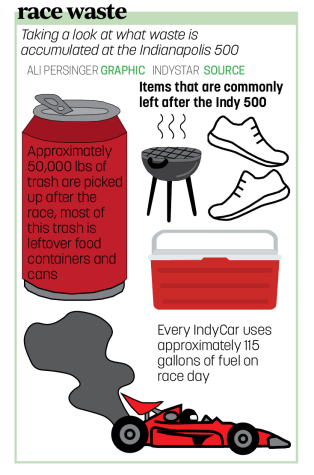The Indianapolis 500, taking place on May 29 this year, is one of the largest sports events in the world, attracting millions of visitors to Indianapolis. Annually, over 300,000 spectators converge on the Indianapolis Motor Speedway (IMS) on race day to watch the race.
However, with an event of this scale, there are bound to be environmental issues stemming both from the cars themselves to the sheer number of spectators descending upon the IMS to watch.
According to senior Connor Lathrop, who has attended the race annually for over a decade, some of these issues are simply part of having so many people in one area for one event.
“There are obviously a lot of people and there is a lot of trash and food used, but it’s not much different than any other big event,” Lathrop said. “A lot of people also drive to the Super Bowl or the NBA Finals, and they also use up trash in those events. So there’s a lot of consumption at the Indy 500, but it’s just like other big events.”
But despite these issues, there are numerous initiatives, both within IndyCar and the wider community, to make the race and driving in general more sustainable.
Lathrop said he admired the innovations that have happened in motorsports and their broader applications into regular vehicles.
“The cool thing about the cars is that they’re testing out new technologies that one day will hopefully be in one of our cars,” Lathrop said. “I saw this thing where the programs used for planning in (Formula 1) made it into airports, which is really interesting because motorsports is the breeding ground for innovation.”

Sophomore Oliver Rosewell, who maintains an interest in cars and has worked frequently with his own car, said the innovations that come with improving performance have also made IndyCars more efficient.
“The way it takes gasoline into energy, it takes fuel from the fuel tank and injects it into the air intake. It uses usually a 14-to-1 air to fuel ratio, so it’s not much fuel compared to how much air it takes in. It converts that into horsepower to move the car,” Rosewell said, adding “You can either take away drag, which means there’s less work the car has to put in to go a certain speed or in the engine you can use forced induction to push more air into the car, and that can give you more power without using that much more fuel.”
While the heavy traffic that comes with driving to the event also causes issues, spectators have found ways to both reduce emissions and save time. Lathrop said he carpools with family and relatives to save emissions, while others have chosen an alternative: bicycling with the “Bike to Indy 500” program.
“‘Bike to the 500’ is one of the 500 Forward Community Engagement initiatives of the Indianapolis Motor Speedway. The idea came from watching the bumper-to-bumper traffic on race day and thinking, “There must be a better way to get to the race,’” Damon Richards, executive director of Bike Indianapolis, said via email. “Lots of people were already biking to the race, but they had no good place to park their bikes while attending the race. Many of our regular riders have stated that they had stopped attending the race because of the traffic difficulty until this option became available.”
However, aside from the environmental benefits, Richards said the event was also simply a fun way to travel to the race while circumventing much of the traffic.
Richards said, “It’s designed to be a safe and fun way to get to the greatest spectacle in racing. Certainly removing potentially hundreds of idling cars from our streets that morning has a real, measurable environmental benefit, but in this case, that’s a side benefit of traveling by one of the most fun forms of transportation. The goal of this event is to demonstrate that bicycling is an option for transportation as well as fitness and recreation.”
In a similar fashion, Rosewell said environmental concerns have been secondary in his decision-making with his own cars and he wishes to incorporate more of it into his future thinking.
“I feel like electric technology is going to be a big part of cars in the future,” he said. “Obviously, fossil fuels aren’t sustainable and we know that, so figuring out how to personalize electric vehicles in the future, because you can’t work with things like exhaust or intakes or anything to the engine.
“Personally, I would say (what motivates my decision-making is) just what I get out of it, whether it be more power or different looks. I would also say money is another big one, which is obvious,” Rosewell added. “I would say that I have thought about the environmental impacts before, but I don’t think I’ve thought about them enough. I should have thought about them more on some choices I’ve made.”


































![AI in films like "The Brutalist" is convenient, but shouldn’t take priority [opinion]](https://hilite.org/wp-content/uploads/2025/02/catherine-cover-1200x471.jpg)










































![Review: “The Immortal Soul Salvage Yard:” A criminally underrated poetry collection [MUSE]](https://hilite.org/wp-content/uploads/2025/03/71cju6TvqmL._AC_UF10001000_QL80_.jpg)
![Review: "Dog Man" is Unapologetically Chaotic [MUSE]](https://hilite.org/wp-content/uploads/2025/03/dogman-1200x700.jpg)
![Review: "Ne Zha 2": The WeChat family reunion I didn’t know I needed [MUSE]](https://hilite.org/wp-content/uploads/2025/03/unnamed-4.png)
![Review in Print: Maripaz Villar brings a delightfully unique style to the world of WEBTOON [MUSE]](https://hilite.org/wp-content/uploads/2023/12/maripazcover-1200x960.jpg)
![Review: “The Sword of Kaigen” is a masterpiece [MUSE]](https://hilite.org/wp-content/uploads/2023/11/Screenshot-2023-11-26-201051.png)
![Review: Gateron Oil Kings, great linear switches, okay price [MUSE]](https://hilite.org/wp-content/uploads/2023/11/Screenshot-2023-11-26-200553.png)
![Review: “A Haunting in Venice” is a significant improvement from other Agatha Christie adaptations [MUSE]](https://hilite.org/wp-content/uploads/2023/11/e7ee2938a6d422669771bce6d8088521.jpg)
![Review: A Thanksgiving story from elementary school, still just as interesting [MUSE]](https://hilite.org/wp-content/uploads/2023/11/Screenshot-2023-11-26-195514-987x1200.png)
![Review: "When I Fly Towards You", cute, uplifting youth drama [MUSE]](https://hilite.org/wp-content/uploads/2023/09/When-I-Fly-Towards-You-Chinese-drama.png)
![Postcards from Muse: Hawaii Travel Diary [MUSE]](https://hilite.org/wp-content/uploads/2023/09/My-project-1-1200x1200.jpg)
![Review: "Ladybug & Cat Noir: The Movie," departure from original show [MUSE]](https://hilite.org/wp-content/uploads/2023/09/Ladybug__Cat_Noir_-_The_Movie_poster.jpg)
![Review in Print: "Hidden Love" is the cute, uplifting drama everyone needs [MUSE]](https://hilite.org/wp-content/uploads/2023/09/hiddenlovecover-e1693597208225-1030x1200.png)
![Review in Print: "Heartstopper" is the heartwarming queer romance we all need [MUSE]](https://hilite.org/wp-content/uploads/2023/08/museheartstoppercover-1200x654.png)




